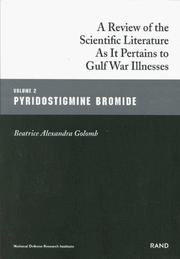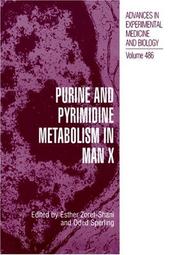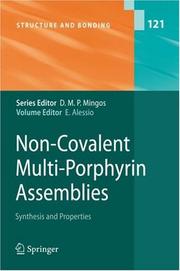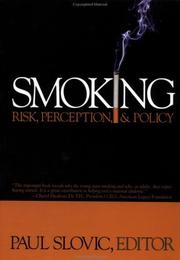| Listing 1 - 10 of 29 | << page >> |
Sort by
|
Book
ISBN: 0841201811 Year: 1973 Volume: 120 Publisher: Washington : ACS - American Chemical Society,
Abstract | Keywords | Export | Availability | Bookmark
 Loading...
Loading...Choose an application
- Reference Manager
- EndNote
- RefWorks (Direct export to RefWorks)
Chlorodibenzodioxins --- Dioxins --- Congresses --- Analysis --- Heterocyclic Compounds, 1-Ring --- Heterocyclic Compounds --- Chemicals and Drugs --- Chemistry --- Physical Sciences & Mathematics --- Chemistry - General --- Organic Chemistry --- Congresses. --- analysis --- Ecology. --- Herbicides --- Physical property --- Toxicity


ISBN: 0833055518 0585302359 9780833055514 0585308896 9780585308890 9780833026774 0833027956 9780585302355 9780833027955 0833026771 0833026771 Year: 1999 Publisher: [Place of publication not identified] RAND Corporation The
Abstract | Keywords | Export | Availability | Bookmark
 Loading...
Loading...Choose an application
- Reference Manager
- EndNote
- RefWorks (Direct export to RefWorks)
Persian Gulf Syndrome --- Pyridostigmine Bromide --- Occupational Diseases --- Pyridinium Compounds --- Pyridines --- Diseases --- Heterocyclic Compounds, 1-Ring --- Heterocyclic Compounds --- Chemicals and Drugs --- Pathology --- Medicine --- Health & Biological Sciences --- Diseases, Occupational --- Occupational Illnesses --- Disease, Occupational --- Illnesse, Occupational --- Illnesses, Occupational --- Occupational Disease --- Occupational Illnesse --- Accidents, Occupational --- Industry --- Occupational Medicine --- Karoshi Death --- Mestinon --- Pyridostigmine --- Bromide, Pyridostigmine --- Heterocyclic Compound --- Compound, Heterocyclic --- Compounds, Heterocyclic --- Polycyclic Compounds --- Heterocyclic Cpds, 1-Ring --- 1-Ring Heterocyclic Compounds --- 1-Ring Heterocyclic Cpds --- Heterocyclic Compounds, 1 Ring --- Heterocyclic Cpds, 1 Ring --- Gulf War Syndrome --- Syndrome, Gulf War --- Syndrome, Persian Gulf --- Environmental Exposure --- Multiple Chemical Sensitivity --- Piperidines --- Compounds, Pyridinium --- Quaternary Ammonium Compounds --- Persian Gulf Syndrome. --- Pyridostigmine Bromide. --- Occupational Diseases. --- Pyridinium Compounds. --- Pyridines. --- Disease. --- Heterocyclic Compounds, 1-Ring. --- Heterocyclic Compounds.
Book
ISBN: 0128023317 0128021926 9780128021927 Year: 2015 Publisher: Amsterdam, [Netherlands] : Academic Press,
Abstract | Keywords | Export | Availability | Bookmark
 Loading...
Loading...Choose an application
- Reference Manager
- EndNote
- RefWorks (Direct export to RefWorks)
RNA Modification provides a useful examination of the science and its role in biological regulation, the current frontier of life science research, and includes various RNA modications and their role in gene expression. It represents the most up-to-date knowledge and protocols available today.
- Dynamic RNA modifications and their roles in biological regulation are the current frontier of life science research
- This volume of Methods in Enzymology represents up to date knowledge and protocols
RNA Processing, Post-Transcriptional --- Pseudouridine --- RNA, Transfer --- Gene Expression Regulation --- Uridine --- Biochemical Processes --- RNA --- Metabolism --- Genetic Processes --- Ribonucleosides --- Pyrimidine Nucleosides --- Biochemical Phenomena --- Chemical Processes --- Nucleic Acids --- Metabolic Phenomena --- Nucleosides --- Genetic Phenomena --- Nucleic Acids, Nucleotides, and Nucleosides --- Phenomena and Processes --- Chemical Phenomena --- Pyrimidines --- Chemicals and Drugs --- Heterocyclic Compounds, 1-Ring --- Heterocyclic Compounds --- Animal Biochemistry --- Human Anatomy & Physiology --- Health & Biological Sciences --- RNA editing. --- ARN --- pharmacokinetics --- Edition --- Editing, RNA --- Messenger RNA editing --- mRNA editing --- RNA Processing, Post-Transcriptional. --- pharmacokinetics. --- Genetic regulation
Book
ISBN: 321199324X 3211993223 1282509330 9786612509339 3211993231 Year: 2010 Publisher: Wien ; New York : Springer,
Abstract | Keywords | Export | Availability | Bookmark
 Loading...
Loading...Choose an application
- Reference Manager
- EndNote
- RefWorks (Direct export to RefWorks)
Despite the long association of organohalogen compounds with human activities, nature is the producer of nearly 5,000 halogen-containing chemicals. Once dismissed as accidents of nature or isolation artifacts, organohalogen compounds represent an important and ever growing class of natural products, in many cases exhibiting exceptional biological activity. Since the last comprehensive review in 1996 (Vol. 68, this series), there have been discovered an additional 2,500 organochlorine, organobromine, and other organohalogen compounds. These natural organohalogens are biosynthesized by bacteria, fungi, lichen, plants, marine organisms of all types, insects, and higher animals including humans. These compounds are also formed abiogenically, as in volcanoes, forest fires, and other geothermal events.In some instances, natural organohalogens are precisely the same chemicals that man synthesizes for industrial use, and some of the quantities of these natural chemicals far exceed the quantities emitted by man.
Environmental toxicology. --- Halogen compounds. --- Organohalogen compounds. --- Persistent pollutants. --- Organohalogen compounds --- Heterocyclic Compounds, 1-Ring --- Dioxins --- Heterocyclic Compounds --- Chemicals and Drugs --- Civil & Environmental Engineering --- Chemistry --- Environmental Engineering --- Biochemistry --- Physical Sciences & Mathematics --- Engineering & Applied Sciences --- Biodegradation. --- Biocorrosion --- Biodecay --- Biodecomposition --- Biodeterioration --- Biological corrosion --- Biological decay --- Biological decomposition --- Biological degradation --- Decay, Biological --- Decomposition (Biology) --- Degradation, Biological --- Halogen organic compounds --- Halogenated organic compounds --- Chemistry. --- Pharmacy. --- Organic chemistry. --- Organic Chemistry. --- Decomposition (Chemistry) --- Microbiology --- Halogen compounds --- Organic compounds --- Chemistry, Organic. --- Medicine --- Drugs --- Materia medica --- Pharmacology --- Organic chemistry

ISBN: 1280043075 9786610043071 0306468433 0306465159 9780306465154 9780306468438 Year: 2002 Publisher: New York, New York : Kluwer Academic Publishers,
Abstract | Keywords | Export | Availability | Bookmark
 Loading...
Loading...Choose an application
- Reference Manager
- EndNote
- RefWorks (Direct export to RefWorks)
th This volume contains articles presented at the X International Symposium on Purines and Pyrimidines in Man, held on May 14 19, 2000 in Tel Aviv, Israel. The first symposium in this series took place in Tel Aviv in 1973. Since then, the symposium has been held every three years in different parts of the world, including Europe, USA and Japan. The participants, in this series of symposia, are characterised by a wide interest in the various aspects of purines and pyrimidines in man, which include biochemistry, genetics, pharmacology, physiology, clinics, etc. Presentations in the symposia include clarification of metabolic pathways, characterisation of enzyme structure and kinetics and discoveries of new inborn errors of metabolism and suggestions for new therapeutic approaches for these inborn errors. In addition, development of new purine and pyrimidine derivatives for the treatment of cancer and viral diseases, and many more subjects of mutual interest were brought to the fore. With the development of therapeutic means and of new research tools, we have witnessed changes in the areas of interest. The interest in gout and uric acid urolithiasis has lessened, whereas molecular aspects, the role of purine and pyrimidine substances in neurotransmission and in purinergic signaling appear to gain greater interest. The articles, included in this volume, contain new data pertaining to the various aspects detailed above.
Electronic books. -- local. --- Purines -- Metabolism -- Congresses. --- Purines -- Metabolism -- Disorders -- Congresses. --- Pyrimidines -- Metabolism -- Congresses. --- Pyrimidines -- Metabolism -- Disorders -- Congresses. --- Purines --- Pyrimidines --- Metabolism, Inborn Errors --- Publication Formats --- Metabolic Phenomena --- Heterocyclic Compounds, 1-Ring --- Heterocyclic Compounds, 2-Ring --- Phenomena and Processes --- Publication Characteristics --- Heterocyclic Compounds --- Metabolic Diseases --- Genetic Diseases, Inborn --- Nutritional and Metabolic Diseases --- Chemicals and Drugs --- Congenital, Hereditary, and Neonatal Diseases and Abnormalities --- Diseases --- Purine-Pyrimidine Metabolism, Inborn Errors --- Congresses --- Metabolism --- Disorders --- Life sciences. --- Cancer research. --- Medical biochemistry. --- Biochemistry. --- Life Sciences. --- Biochemistry, general. --- Medical Biochemistry. --- Cancer Research. --- Oncology. --- Cancer research --- Medical biochemistry --- Pathobiochemistry --- Pathological biochemistry --- Biochemistry --- Pathology --- Biological chemistry --- Chemical composition of organisms --- Organisms --- Physiological chemistry --- Biology --- Chemistry --- Medical sciences --- Composition --- Heterocyclic compounds --- Uric acid
Book
ISBN: 1441926917 0387785175 9786612824937 0387785183 1282824937 Year: 2009 Publisher: Austin, Tex. : New York, N.Y. : Landes Bioscience ; Springer Science & Business Media,
Abstract | Keywords | Export | Availability | Bookmark
 Loading...
Loading...Choose an application
- Reference Manager
- EndNote
- RefWorks (Direct export to RefWorks)
Excluding the biological polymers proteins, lipids and nucleic acids, modified tetrapyrroles are the biological molecules that have had the greatest impact on the evolution of life over the past 4 billion years. They are involved in a wide variety of fundamental processes that underpin central primary metabolism in all kingdoms of life, from photosynthesis to methanogenesis. Moreover, they bring colour into the world and it is for this reason that these compounds have been appropriately dubbed the ‘pigments of life’. To understand how and why these molecules have been so universally integrated into the life processes one has to appreciate the chemical properties of the tetrapyrrole scaffold and, where appropriate, the chemical characteristics of the centrally chelated metal ion. This book addresses why these molecules are employed in Nature, how they are made and what happens to them after they have finished their usefulness.
Chlorophyll. --- Heme. --- Porphyrins. --- Tetrapyrroles --- Chlorophyll --- Porphyrins --- Heme --- Macrocyclic Compounds --- Pyrroles --- Heterocyclic Compounds with 4 or More Rings --- Azoles --- Heterocyclic Compounds --- Polycyclic Compounds --- Chemicals and Drugs --- Heterocyclic Compounds, 1-Ring --- Animal Biochemistry --- Botany - General --- Human Anatomy & Physiology --- Botany --- Health & Biological Sciences --- Earth & Environmental Sciences --- Tetrapyrroles. --- Hematin --- Porphyrin and porphyrin compounds --- Life sciences. --- Plant science. --- Botany. --- Life Sciences. --- Plant Sciences. --- Botanical science --- Phytobiology --- Phytography --- Phytology --- Plant biology --- Plant science --- Biology --- Natural history --- Plants --- Biosciences --- Sciences, Life --- Science --- Macrocyclic compounds --- Pigments (Biology) --- Chloroplast pigments --- Photosynthetic pigments --- Plant photoreceptors --- Floristic botany
Book
ISBN: 030928886X 0309288878 0309288894 Year: 2014 Publisher: Washington, District of Columbia : National Academies Press,
Abstract | Keywords | Export | Availability | Bookmark
 Loading...
Loading...Choose an application
- Reference Manager
- EndNote
- RefWorks (Direct export to RefWorks)
"From 1962 to 1971, the US military sprayed herbicides over Vietnam to strip the thick jungle canopy that could conceal opposition forces, to destroy crops that those forces might depend on, and to clear tall grasses and bushes from the perimeters of US base camps and outlying fire-support bases. Mixtures of 2,4-dichlorophenoxyacetic acid (2,4-D), 2,4,5-trichlorophenoxyacetic acid (2,4,5-T), picloram, and cacodylic acid made up the bulk of the herbicides sprayed. The main chemical mixture sprayed was Agent Orange, a 50:50 mixture of 2,4-D and 2,4,5-T. At the time of the spraying, 2,3,7,8-tetrachlorodibenzo-p-dioxin (TCDD), the most toxic form of dioxin, was an unintended contaminant generated during the production of 2,4,5-T and so was present in Agent Orange and some other formulations sprayed in Vietnam. Because of complaints from returning Vietnam veterans about their own health and that of their children combined with emerging toxicologic evidence of adverse effects of phenoxy herbicides and TCDD, the National Academy of Sciences (NAS) was asked to perform a comprehensive evaluation of scientific and medical information regarding the health effects of exposure to Agent Orange, other herbicides used in Vietnam, and the various components of those herbicides, including TCDD. Updated evaluations are conducted every two years to review newly available literature and draw conclusions from the overall evidence.Veterans and Agent Orange: Update 2012 reviews peer-reviewed scientific reports concerning associations between health outcomes and exposure to TCDD and other chemicals in the herbicides used in Vietnam that were published in October 2010--September 2012 and integrates this information wi650 th the previously established evidence database. This report considers whether a statistical association with herbicide exposure exists, taking into account the strength of the scientific evidence and the appropriateness of the statistical and epidemiological methods used to detect the association; the increased risk of disease among those exposed to herbicides during service in the Republic of Vietnam during the Vietnam era; and whether there exists a plausible biological mechanism or other evidence of a causal relationship between herbicide exposure and the disease"--Publisher's description.
Vietnam War, 1961-1975 -- Veterans -- Diseases. --- Vietnam War, 1961-1975 -- Veterans -- Health aspects. --- Agent Orange --- Vietnam War, 1961-1975 --- Herbicides --- Epidemiology --- Heterocyclic Compounds, 1-Ring --- Pesticides --- Environmental Pollution --- Health --- North America --- History, 20th Century --- Asia, Southeastern --- Asia --- Toxic Actions --- Agrochemicals --- Heterocyclic Compounds --- History, Modern 1601 --- -Population Characteristics --- Americas --- Public Health --- Specialty Uses of Chemicals --- Chemical Actions and Uses --- History --- Chemicals and Drugs --- Environment and Public Health --- Geographic Locations --- Health Care --- Geographicals --- Humanities --- Defoliants, Chemical --- Tetrachlorodibenzodioxin --- United States --- Vietnam --- Vietnam Conflict --- Occupational Exposure --- Dioxins --- Environmental Exposure --- Veterans Health --- Toxicology --- Health aspects --- Veterans --- Diseases --- Health aspects. --- Diseases. --- Toxicology.

ISSN: 00815993 ISBN: 9783540325420 3540325425 3540325433 Year: 2006 Volume: 121 Publisher: Berlin, Heidelberg : Springer Berlin Heidelberg : Imprint: Springer,
Abstract | Keywords | Export | Availability | Bookmark
 Loading...
Loading...Choose an application
- Reference Manager
- EndNote
- RefWorks (Direct export to RefWorks)
Porphyrins --- Synthesis --- chemical synthesis --- Chemistry. --- Chemistry, inorganic. --- Chemistry, Organic. --- Chemistry, Physical organic. --- Inorganic Chemistry. --- Physical Chemistry. --- Organic Chemistry. --- Pigments, Biological --- Tetrapyrroles --- Heterocyclic Compounds with 4 or More Rings --- Pyrroles --- Macrocyclic Compounds --- Biological Factors --- Heterocyclic Compounds --- Chemicals and Drugs --- Polycyclic Compounds --- Azoles --- Heterocyclic Compounds, 1-Ring --- Animal Biochemistry --- Physical & Theoretical Chemistry --- Inorganic Chemistry --- Chemistry --- Human Anatomy & Physiology --- Health & Biological Sciences --- Physical Sciences & Mathematics --- Porphyrins. --- Synthesis. --- Heterocyclic Cpds, 1-Ring --- 1-Ring Heterocyclic Compounds --- 1-Ring Heterocyclic Cpds --- Heterocyclic Compounds, 1 Ring --- Heterocyclic Cpds, 1 Ring --- Compounds, Polycyclic --- Compounds, Heterocyclic --- Biologic Agents --- Biologic Factors --- Biological Factor --- Factor, Biologic --- Factor, Biological --- Factors, Biological --- Biological Agents --- Agents, Biologic --- Agents, Biological --- Biologic Factor --- Factors, Biologic --- Macrocycle Compounds --- Spherands --- Torands --- Compounds, Macrocycle --- Compounds, Macrocyclic --- Biological Pigments --- Porphyrin and porphyrin compounds --- Chemistry, Physical organic --- Organic chemistry --- Inorganic chemistry --- Five Ring Heterocyclic Compounds --- Four Ring Heterocyclic Compounds --- Fused Heterocyclic Compounds, Five-Ring --- Fused Heterocyclic Compounds, Four-Ring --- Heterocyclic Compounds with Four or More Rings --- Heterocyclic Compounds, 4-Ring --- Heterocyclic Compounds, 5-Ring --- Heterocyclic Cpds, 4 Ring --- Heterocyclic Cpds, 4 or More Rings --- Heterocyclic Cpds, 5 Ring --- 4-Ring Heterocyclic Compounds --- 5-Ring Heterocyclic Compounds --- Fused Heterocyclic Compounds, Five Ring --- Fused Heterocyclic Compounds, Four Ring --- Heterocyclic Compounds, 4 Ring --- Heterocyclic Compounds, 5 Ring --- Inorganic chemistry. --- Organic chemistry. --- Physical chemistry. --- Chemistry, Organic --- Chemistry, Physical and theoretical --- Inorganic compounds --- Chemistry, Theoretical --- Physical chemistry --- Theoretical chemistry

ISBN: 0520213726 0520205723 0520920996 058506878X 9780520920996 9780585068787 9780520205727 9780520213722 Year: 1996 Publisher: Berkeley University of California press
Abstract | Keywords | Export | Availability | Bookmark
 Loading...
Loading...Choose an application
- Reference Manager
- EndNote
- RefWorks (Direct export to RefWorks)
Around-the-clock tobacco talks, multibillion-dollar lawsuits against the major cigarette companies, and legislative wrangling over how much to tax a pack of cigarettes-these are some of the most recent episodes in the war against the tobacco companies. The Cigarette Papers shows what started it all: revelations that tobacco companies had long known the grave dangers of smoking, and did nothing about it.In May 1994 a box containing 4,000 pages of internal tobacco industry documents arrived at the office of Professor Stanton Glantz at the University of California, San Francisco. The anonymous source of these "cigarette papers" was identified only as "Mr. Butts." These documents provide a shocking inside account of the activities of one tobacco company, Brown & Williamson, over more than thirty years. Quoting extensively from the documents themselves and analyzing what they reveal, The Cigarette Papers shows what the tobacco companies have known and galvanizes us to take action.
Tobacco industry --- Tobacco use --- Nicotine --- Smoking. --- Tobacco. --- Cigarettes --- Habits --- Pyridines --- Solanaceae --- Solanaceous Alkaloids --- Heterocyclic Compounds, 1-Ring --- Heterocyclic Compounds --- Embryophyta --- Streptophyta --- Viridiplantae --- Additives --- Cigar Smoking --- Cigarette Smoking --- Hookah Smoking --- Smoking, Tobacco --- Waterpipe Smoking --- Pipe Smoking --- Tobacco Smoking --- Smoking, Cigar --- Smoking, Cigarette --- Smoking, Hookah --- Smoking, Pipe --- Smoking, Waterpipe --- Nicotiana tabacums --- Nicotianas --- Tobaccos --- tabacum, Nicotiana --- Nicotine Bitartrate --- Nicotine Tartrate --- Bitartrate, Nicotine --- Tartrate, Nicotine --- Eucarya --- Eukarya --- Eukaryotes --- Eukaryotas --- Eukaryote --- Plant --- Land Plants --- Land Plant --- Plant, Land --- Plants, Land --- Compounds, Heterocyclic --- Heterocyclic Cpds, 1-Ring --- 1-Ring Heterocyclic Compounds --- 1-Ring Heterocyclic Cpds --- Heterocyclic Compounds, 1 Ring --- Heterocyclic Cpds, 1 Ring --- Angiospermae --- Liliopsida --- Magnoliopsida --- Angiosperm --- Liliopsidas --- Magnoliopsidas --- Habit Disturbances --- Habit Disturbance --- Tobacco manufacture and trade --- Tobacco products industry --- Cigarets --- Cigarette habit --- Cigarette smoking --- Tobacco smoking --- Green Plants --- Green Plant --- Plant, Green --- Plants, Green --- Solanum Alkaloids --- Alkaloids, Solanaceous --- Alkaloids, Solanum --- Acnistus --- Brugmansia --- Dunalia --- Brugmansias --- Dunalias --- -Tobacco --- -Tobacco industry --- -Cigarettes --- Tobacco products --- Plant products industry --- Smoking --- Industry --- Technology, Industry, and Agriculture --- Technology, Industry, Agriculture --- Angiosperms --- Behavior --- Alkaloids --- Behavior and Behavior Mechanisms --- Chemicals and Drugs --- Psychiatry and Psychology --- Plants --- Eukaryota --- Organisms --- Tobacco --- Business & Economics --- Industries --- Smoking Behaviors --- Smoking Habit --- Behavior, Smoking --- Behaviors, Smoking --- Habit, Smoking --- Habits, Smoking --- Smoking Behavior --- Smoking Habits --- Tertiary Sector --- Sector, Tertiary --- Sectors, Tertiary --- Tertiary Sectors --- Commerce --- Ethics, Business --- Nicotiana tabacum --- Nicotiana --- Acceptance Process --- Acceptance Processes --- Behaviors --- Process, Acceptance --- Processes, Acceptance --- Botany --- Plant Proteins --- Ethnopharmacology --- Polycyclic Compounds --- Plant Alkaloids --- Alkaloids, Plant --- Angiosperma --- Arecidae --- Asteridae --- Caryophyllidae --- Commelinidae --- Dicotyledoneae --- Dilleniidae --- Flowering Plants --- Hamamelidae --- Hamamelididae --- Icacinales --- Liliatae --- Liliidae --- Magnoliatae --- Metteniusales --- Oncothecales --- Rosidae --- Vahliales --- Zingiberidae --- Flowering Plant --- Icacinale --- Metteniusale --- Oncothecale --- Plant, Flowering --- Plants, Flowering --- Vahliale --- Piperidines --- Habit --- Health aspects. --- legislation. --- adverse effects. --- Health aspects --- United States --- Additives. --- Tobacco industry - United States. --- Tobacco - Health aspects. --- #SBIB:002.IO --- #SBIB:316.334.3M20 --- #SBIB:35H411 --- #SBIB:35H436 --- Sociale epidemiologie en etiologie: sociale aspecten van ziekte en gezondheid --- Beleidscyclus: voorbereiding (inclusief planning) --- Beleidssectoren: welzijn, volksgezondheid en cultuur --- Behavior And Behavior Mechanism --- Heterocyclic Compound --- Compound, Heterocyclic --- Alkaloid --- Plant Alkaloid --- Alkaloid, Plant --- Technology --- Psychology --- Factors, Psychological --- Psychological Factors --- Psychological Side Effects --- Psychologists --- Psychosocial Factors --- Side Effects, Psychological --- Factor, Psychological --- Factor, Psychosocial --- Factors, Psychosocial --- Psychological Factor --- Psychological Side Effect --- Psychologist --- Psychosocial Factor --- Side Effect, Psychological --- Arts, Industrial --- Industrial Arts --- Cloud Computing --- Industry. --- Cigarettes. --- Habits. --- Technology, Industry, and Agriculture. --- Pyridines. --- Solanaceae. --- Solanaceous Alkaloids. --- Technology. --- Magnoliopsida. --- Behavior. --- Alkaloids. --- Heterocyclic Compounds, 1-Ring. --- Heterocyclic Compounds. --- Embryophyta. --- Behavior and Behavior Mechanisms. --- Psychology. --- Streptophyta. --- Viridiplantae. --- Plants. --- Eukaryota. --- Nicotine. --- United States.

ISBN: 0761923802 0761923810 1452232652 1322416656 1452267014 9781452267012 9781452232652 9780761923817 9780761923800 9781322416656 Year: 2001 Publisher: Thousand Oaks, CA Sage Publications
Abstract | Keywords | Export | Availability | Bookmark
 Loading...
Loading...Choose an application
- Reference Manager
- EndNote
- RefWorks (Direct export to RefWorks)
The basis for this study are two extensive telephone surveys (designed by Slovic and the other contributors to this volume) that were conducted between 1999- 2000, recording the responses of over 4000 people.
Smoking --- Nicotine --- Cigarette smokers --- Risk perception --- Health aspects --- Attitudes --- Health risk assessment --- Government policy --- Cigarette smokers - Attitudes. --- Nicotine - Health aspects. --- Smoking - Health aspects. --- Delivery of Health Care --- Public Policy --- Behavior --- Communication --- Solanaceous Alkaloids --- Attitude --- Pyridines --- Marketing --- Habits --- Social Control Policies --- Information Science --- Commerce --- Behavior and Behavior Mechanisms --- Heterocyclic Compounds, 1-Ring --- Alkaloids --- Health Care Quality, Access, and Evaluation --- Heterocyclic Compounds --- Policy --- Psychiatry and Psychology --- Health Care --- Social Control, Formal --- Technology, Industry, and Agriculture --- Health Care Economics and Organizations --- Chemicals and Drugs --- Social Sciences --- Sociology --- Technology, Industry, Agriculture --- Anthropology, Education, Sociology and Social Phenomena --- Attitude to Health --- Health Policy --- Risk-Taking --- Advertising as Topic --- Psychiatry --- Health & Biological Sciences --- Substance Abuse Disorders --- Risk perception. --- Health aspects. --- Attitudes. --- Health risk assessment. --- Government policy. --- Cigarette habit --- Cigarette smoking --- Tobacco smoking --- Awareness, Risk --- Risk awareness --- Smokers, Cigarette --- Tobacco use --- Perception --- Persons --- Pyridine --- Tobacco --- Tobacco products --- Smoking - Health aspects --- Nicotine - Health aspects --- Cigarette smokers - Attitudes --- Cigarette smokers - Health risk assessment --- Smoking - Government policy
| Listing 1 - 10 of 29 | << page >> |
Sort by
|

 Search
Search Feedback
Feedback About UniCat
About UniCat  Help
Help News
News